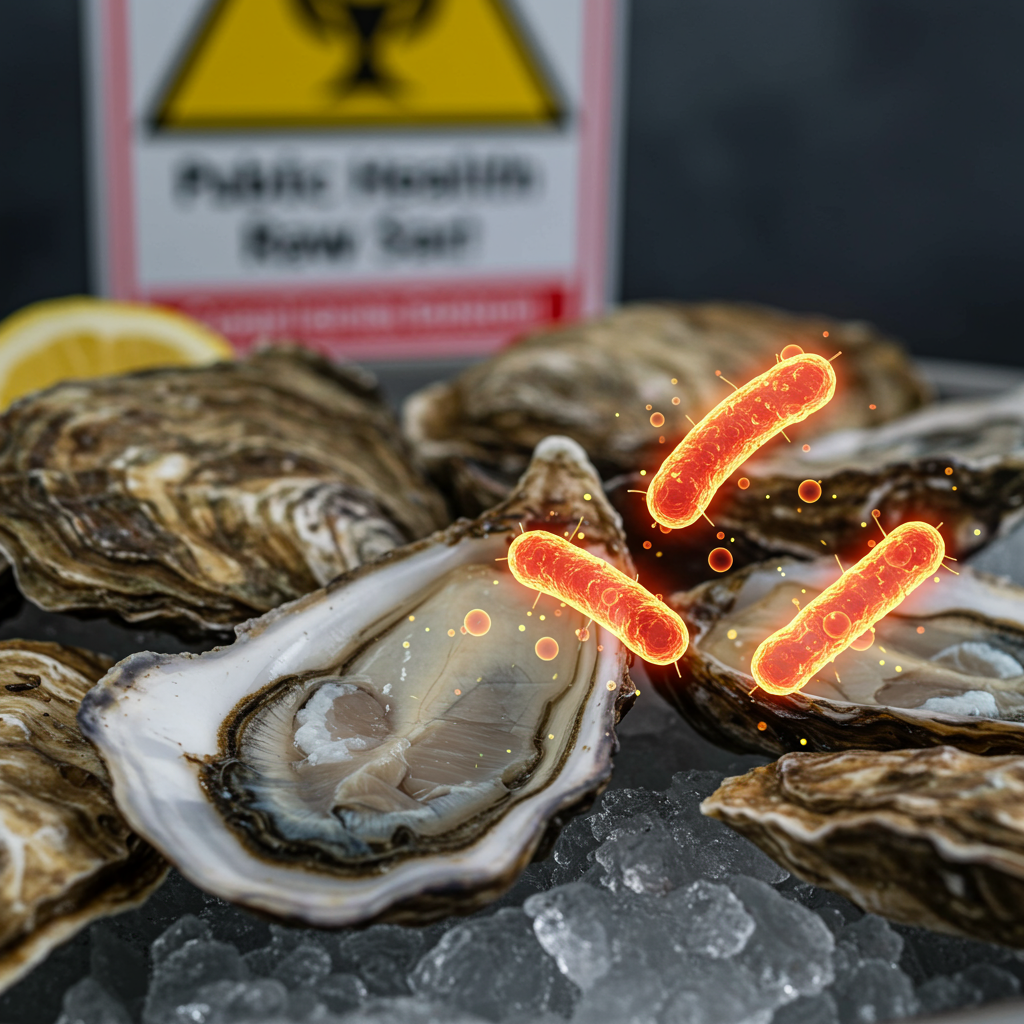The enjoyment of raw oysters, a cherished delicacy for many, has taken a tragic turn in Louisiana, sparking urgent health warnings across the United States. State officials have confirmed a significant and alarming rise in Vibrio vulnificus infections, often referred to as “flesh-eating bacteria,” with several fatalities directly linked to consuming contaminated raw shellfish. This concerning trend, exacerbated by warming coastal waters, demands immediate attention to safeguard public health and ensure responsible seafood consumption.
Understanding the Alarming Rise of Vibrio vulnificus
Vibrio vulnificus is a naturally occurring bacterium found in warm, brackish coastal waters. While not new, its prevalence and the severity of infections are escalating, particularly between May and October when water temperatures are highest. This year, Louisiana has faced an unprecedented surge in cases. Latest reports from the Louisiana Department of Health indicate 34 Vibrio vulnificus infections for 2025 alone, resulting in six confirmed deaths. This drastically surpasses the state’s average of just seven infections and one death per year over the past decade, signaling a critical public health crisis.
The bacterium poses a serious threat through two primary pathways: consuming raw or undercooked seafood, especially oysters, and exposing open wounds to contaminated seawater. The Centers for Disease Control and Prevention (CDC) warns that Vibrio vulnificus boasts the highest fatality rate among all foodborne pathogens, accounting for over 95% of seafood-related deaths in the U.S. Nationally, an estimated 80,000 Vibrio infections occur annually, leading to approximately 500 hospitalizations and 100 deaths.
The Deadly Link to Raw Oysters
Among the recent fatalities in Louisiana, at least two individuals died after consuming raw oysters harvested from the state. One victim was a Louisiana resident, while the other lived out-of-state. These tragic incidents unfolded after contaminated oysters were served at different restaurants – one within Louisiana and another in Florida, underscoring the potential for widespread impact. State health officials specifically identify raw oysters as a particularly high-risk food source due to their filter-feeding nature, which can concentrate bacteria from their aquatic environment.
The Louisiana Oyster Task Force has been actively addressing these concerns, with health department officials presenting critical data on oyster-related illnesses. The sheer volume of cases tied to seafood consumption highlights a persistent vulnerability despite industry efforts.
More Than Just Seafood: The Risk of Water Exposure
While raw oysters are a significant concern, it’s crucial to remember that Vibrio vulnificus infections also occur from wound exposure to coastal waters. In Louisiana this year, over 80% of the reported infections were linked to open wounds coming into contact with seawater. The remaining deaths were from individuals who reported this type of exposure. This dual threat means vigilance is required not only when dining but also when engaging in water-based activities along the coast. The bacterium cannot penetrate intact skin, but even a small cut or scrape can provide an entry point for a life-threatening infection.
Understanding the “Flesh-Eating” Impact
The term “flesh-eating bacteria” accurately reflects the severe consequences of a Vibrio vulnificus infection. While the bacteria do not literally “eat” flesh, they release toxins that cause body tissues to rapidly die, leading to a condition called necrotizing fasciitis. This aggressive infection can cause widespread tissue destruction, often requiring intensive care, extensive surgical removal of dead tissue, and sometimes even limb amputation to prevent the spread and save the patient’s life.
The progression of the illness can be shockingly fast. Approximately one in five people infected with Vibrio vulnificus die, sometimes within just 24 to 48 hours of symptom onset. Early symptoms can be non-specific, including fever, chills, nausea, vomiting, and diarrhea. For wound infections, localized pain, swelling, and redness may quickly intensify. The rapid onset and severity underscore the critical need for immediate medical attention if an infection is suspected.
A Spreading Threat: Warming Oceans and Geographic Expansion
The escalating number of Vibrio vulnificus cases is not confined to Louisiana. This is a national public health concern, with warming ocean temperatures identified as a major contributing factor. As coastal waters become warmer, they create ideal conditions for the bacteria to thrive and spread. Florida has also reported a significant number of cases this year, with figures ranging from 13 cases with 8 deaths to 23 cases with 5 deaths depending on the reporting period.
Alarmingly, the geographic reach of these infections is expanding northward. Cases have recently been reported as far north as Massachusetts, Connecticut, and New York – regions where Vibrio vulnificus infections were historically less common. This expansion signals a worrying trend, indicating that what was once a localized concern for southern coastal states is becoming a broader challenge for U.S. coastal communities.
Safeguarding Your Health: Prevention and Industry Efforts
Given the rising risks, proactive measures are essential for both consumers and the seafood industry. Consumers should exercise caution, particularly during warmer months.
Essential Prevention Strategies:
Avoid Raw Seafood: The safest approach is to cook oysters and other shellfish thoroughly. High temperatures kill Vibrio vulnificus.
Heed Warnings: Many restaurants are legally required to display warnings about the risks of raw seafood. Take these warnings seriously.
Wound Care: Avoid swimming or exposing open wounds, cuts, or scrapes to warm coastal or brackish waters. If you have a fresh wound and must enter the water, cover it with a waterproof bandage.
Post-Water Hygiene: Always wash thoroughly with soap and water after contact with coastal waters.
High-Risk Individuals: Individuals with weakened immune systems, chronic liver disease, diabetes, or other underlying health conditions are at a significantly higher risk of severe infection and should strictly avoid raw seafood and direct contact with warm coastal waters if they have open wounds.
Industry and Regulatory Measures:
The oyster industry, in collaboration with regulatory bodies like Louisiana Wildlife and Fisheries and the Department of Health, employs various measures to enhance safety. These include:
Traceability Systems: Oyster sacks are tagged with tickets recording harvest location and date. Restaurants are mandated to retain these tickets for 90 days, enabling swift tracing in case of contamination.
Cooling Protocols: Fishermen must adhere to strict cooling methods for oysters once harvested, even when staying at sea for up to 72 hours.
Restaurant Inspections: Health departments conduct regular checks on restaurants every 120 days to ensure compliance with food safety standards.
Cultivation Advancements: Some oyster farms are adopting modern techniques, such as growing oysters on limestone, which is believed to yield a cleaner product compared to traditional methods in marsh mud.
Despite these efforts, the current surge in infections highlights that vulnerabilities persist. Consumer awareness and personal responsibility remain paramount in mitigating the risks associated with this potent pathogen.
Frequently Asked Questions
What exactly is Vibrio vulnificus, and how does it cause illness?
Vibrio vulnificus is a bacterium found naturally in warm coastal waters, particularly prevalent from May to October. It causes illness in humans primarily in two ways: by consuming raw or undercooked seafood (especially oysters) contaminated with the bacteria, or by exposing an open wound to contaminated water. Once inside the body, the bacteria can rapidly multiply and release toxins that cause necrotizing fasciitis, a severe infection where body tissues die, leading to potentially life-threatening conditions like sepsis, limb amputation, or death.
How can I protect myself and my family from Vibrio vulnificus when eating seafood or in coastal waters?
To protect yourself, always thoroughly cook oysters and other seafood to kill any potential bacteria. Avoid consuming raw or undercooked shellfish, particularly if you have a compromised immune system, liver disease, or diabetes. When in coastal waters, avoid swimming or wading if you have any open cuts, scrapes, or wounds. If exposure is unavoidable, cover wounds with a waterproof bandage. Always wash your hands thoroughly with soap and water after handling raw seafood or after contact with coastal waters.
What are the symptoms of a Vibrio vulnificus infection, and when should I seek urgent medical help?
Symptoms of a Vibrio vulnificus infection can appear rapidly, often within 24 hours. They include fever, chills, nausea, vomiting, diarrhea, and abdominal pain. For wound infections, symptoms may include rapidly worsening redness, swelling, intense pain, and skin lesions at the wound site. Given the infection’s rapid progression and high mortality rate, it is crucial to seek immediate medical attention if you experience any of these symptoms, especially after consuming raw seafood or after exposing a wound to warm coastal water. Prompt diagnosis and treatment are vital.
A Call for Vigilance in a Changing Climate
The current rise in Vibrio vulnificus* infections and deaths, particularly those linked to raw oysters, serves as a stark reminder of the evolving challenges in public health. With warming ocean temperatures extending the bacteria’s habitat and season, heightened vigilance is no longer optional but essential. Consumers must be aware of the risks and take proactive steps to protect themselves, while the seafood industry and health officials must continue to adapt and strengthen safety protocols. By staying informed and making conscious choices, we can mitigate the threat of this dangerous “flesh-eating bacteria” and ensure the continued enjoyment of our coastal environments and culinary traditions safely.



